views

Help users face the new challenges of the digital future!
More powerful performance and higher security
Help users face the new challenges of the digital future!
Today, with the release of Intel's latest processors
The PowerEdge R750 was also
Officially launched globally this month
How does it perform?
Professional evaluation agency StorageReview
Tested it for the first time
specific results
Let's have a sneak peek!


ESXi version : 7.0u1
Operating System: CentOS 8.2
StorageReview's Microsoft SQL Server OLTP test protocol features the latest specification of the Transaction Processing Performance Council's Benchmark C (TPC-C), an online transaction processing benchmark used to simulate activity in complex application environments. TPC-C benchmarks are closer to measuring performance benefits and bottlenecks of storage infrastructure in database environments than synthetic performance benchmarks.
Each SQL Server VM is configured with two virtual disk vDisks: a 100GB volume for boot and a 500GB volume for database and log files. From a system resource perspective, they configured each virtual machine (VM) with 16 vCPUs, 64GB DRAM, and leveraged the LSI Logic SAS SCSI controller.
◆ Test time: 3 hours
For SQL Server average latency, the Dell EMC PowerEdge R750 maintained 1ms latency across the entire 8VM.
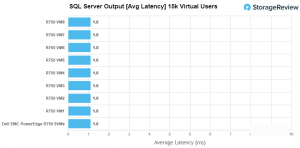
StorageReview's first local storage application benchmark includes a Percona MySQL OLTP database as measured by SysBench. The test also measures average TPS (transactions per second), average latency, and average 99th percentile latency.
Each Sysbench VM was configured with three virtual disks : one for boot (~92GB), one for the prebuilt database (~447GB), and a third for the database under test (270GB). From a system resource perspective, StorageReview configured each VM with 16 vCPUs, 60GB of DRAM, and leveraged the LSI Logic SAS SCSI controller.
◆ Test time: 3 hours
Via Sysbench OLTP, StorageReview recorded a total score of 29,200 TPS for 8 VMs, with a single VM ranging from 3631 to 3665 TPS. With 16VM, the total score for a single VM was 26,800 TPS, and the TPS for a single VM ranged from 1662 to 1690.

In terms of average latency , 8VM provided 8.77ms (milliseconds) latency, and the latency of a single VM ranged from 8.73ms to 8.81ms. 16VMs have a combined latency of 19.1ms, and a single VM runs from 18.87ms to 19.24ms

For worst-case latency (99th percentile), 8VM's latency totaled 15.2ms, while 16VM's totaled 35.4ms.
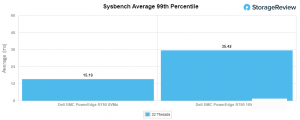
All tests leverage the common VDBench workload generator and automate tests and capture results on large compute test clusters via a scripting engine.
◆ 64K sequential writes: 100% write, 8 threads, 0-120% iorate
◆ Comprehensive database: SQL and Oracle
◆ VDI full clone and linked clone tracking
For 4K random reads , the PowerEdge R750 boot time was under 100µs (microseconds), held until 2.85 million IOPS, then peaked at 5.69 million IOPS, at which point the latency was 608µs.

The PowerEdge R750's 4K random write was impressive , with a latency of only 15.1µs, and stayed below 100µs latency until about 3 million IOPS. The peak IOPS was 3.44 million, and the latency at this time was 986µs.

In the read state, we saw the R750 peak at 644,000 IOPS or 40.3GB/s with a latency of 396µs.

At 64K sequential writes , the PowerEdge R750 demonstrated a peak performance of 252,000 IOPS or 15.8GB/s at 939µs latency.

Next is the SQL workload : including SQL, SQL 90-10 and SQL 80-20.
Starting with SQL, the PowerEdge R750 starts at 81µs and stays below 100µs latency until ~1 million IOPS. The peak IOPS was 1.796 million, and the latency at this time was 141µs.
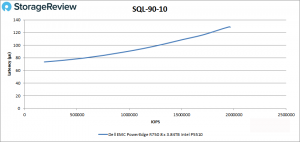
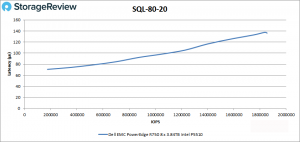
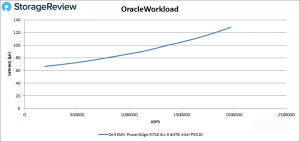
Next is the Oracle workload : including Oracle, Oracle 90-10, and Oracle 80-20.
First for Oracle, the R750 continued to start with low latency (67µs) and peaked at 1.28 million IOPS with a latency of 128µs.

For Oracle 90-10 , the R750 ran with latency below 100µs most of the time. The peak IOPS is 1.69 million, and the latency at this time is only 103µs.
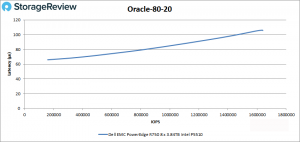
This is followed by the Oracle 80-20 , where we see the R750 again run with sub-100µs latency most of the time. Peak IOPS was 1.64 million and latency was only 106µs.

Next, StorageReview switched to VDI clone testing, i.e. full clones and linked clones .
For VDI full clone (FC) boot, the PowerEdge R750 peaked at 1.466 million IOPS with a latency of just 172µs, then started to drop.
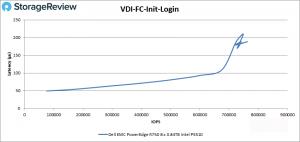
On the VDI FC initial login , PowerEdge stayed below 100µs latency for about three-quarters of the time, then peaked at 763,000 IOPS with 189µs latency.

For VDI FC Monday Login (first login every week), the R750 stayed below 100µs latency until 318,000 IOPS, then peaked at 653µs latency at 654,000 IOPS.
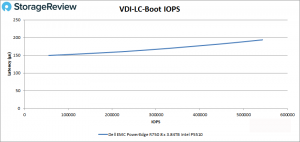
Next up was the VDI Linked Clones (LC) test , which showed a peak performance of 543,000 IOPS and a latency of 194µs.
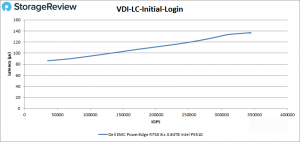
VDI LC initial login , the R750 booted with only 86µs latency, then peaked at 344k IOPS and 136µs latency.

Finally, with the R750 at VDI LC Monday login , we saw a peak of 478,000 IOPS and a latency of 189µs.

Performance-wise, we tested the PowerEdge R750 with application workload analysis and VDBench workloads. In terms of average latency for SQL Server, the server was able to maintain 1ms latency across 8 VMs. For Sysbench, the TPS for the 8 VM settings is 29174, with an average latency of 8.77ms and a worst-case latency of 15.2ms. We saw impressive performance with 8 VMs, one of the highest 8VM performances we've recorded .
With 16 VMs, we see a TPS of 26838, an average latency of 19.1ms, and a worst-case latency of 35.4ms.
The R750 shows very strong low latency performance in VDBench . Highlights include 4K reads at 5.7 million IOPS , 4K writes at 3.4 million IOPS, 64K reads at 40.3GB/s, and 64K writes at 15.8GB/s.
In the SQL workload , we saw peaks of 1.8 million IOPS, 1.96 million IOPS for SQL 90-10, and 1.85 million IOPS for SQL 80-20.
In the Oracle workload , we saw peaks of 1.97 million IOPS, 1.69 million IOPS for the Oracle 90-10, and 1.6 million IOPS for the Oracle 80-20.
In the VDI full clone , we saw 1.47 million IOPS launches, 763,000 IOPS initial logins, and 654,000 IOPS Monday logins. In the VDI linked clone we see 543k IOPS at boot, 344k IOPS at initial login and 478k IOPS at Monday login.
The PowerEdge R750's performance exceeded our expectations . We're excited to see a new generation of Intel-based servers finally arrive, showing the world what it's capable of. Not only is the R750 a powerhouse, but it's also had a great redesign, especially around cooling and NVMe RAID. There are also new BOSS drives and the legendary iDRAC management tool.
https://www.skywardtel.com/Dell-PowerEdge-R750-server-complete-performance-test.html












